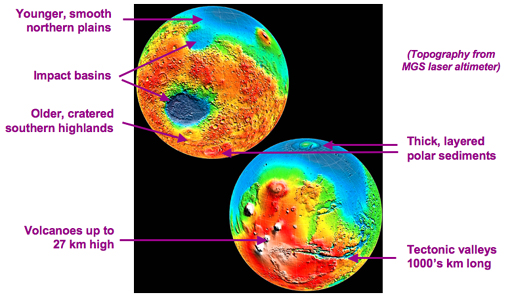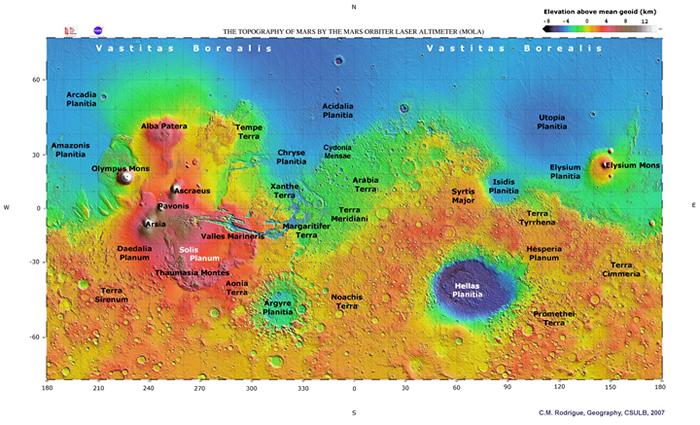Mars Geology
Mars' General Physiography

Color-coded elevation map highlighting key physical features of Mars.
Red is high elevation, blue is low elevation. Adapted from map of Mars' elevation from NASA/JPL.
Mars is a transitional planet, part way in the intensity of its geologic activity between the highly evolved, active Earth and the geologically quiet Moon. The surface consists of two main physical provinces: smooth plains that occur mostly in the northern hemisphere, and densely cratered highlands that occur mostly in the southern hemisphere.
We know that the southern highlands are older because they have accumulated more impact craters, formed by the steady rain of comets and asteroids onto Mars. Although the highlands' absolute age is uncertain, they probably date to 3.8–4.0 billion years of age, similar to the lunar highlands and older than nearly all Earth rocks. (Earth's rocks are recycled into our planet's interior by plate tectonics, so only a few special regions from the first billion years of our planet's history have been preserved. Mars, like the Moon, lacks Earth-type plate tectonics so very old rocks still exist at the surface.) The largest craters are "impact basins," hundreds to thousands of kilometers across.
The northern plains are several kilometers (about 3 miles) lower in elevation than the southern highlands. The presence of many large buried impact basins in the northern plains means that they are old like the southern highlands, but covered by a thin veneer of volcanic lava flows and sediments. These deposits make the plains very smooth – at the scale of a few kilometers they are smoother than any part of Earth’s land surface.
Mars has the largest known volcanoes in the solar system. Five of the biggest, whose tops are 27 kilometers (about 17 miles) above the northern plains, are clustered in a region of the planet known as Tharsis.
Mars has tectonic features, that is, features formed by vertical or horizontal movement of the outer rigid layer of the planet, the "lithosphere." The most conspicuous features are long, narrow troughs surrounding Tharsis, and the mammoth Valles Marineris canyon system.
Like Earth, Mars has ice caps at both
poles. Each ice cap consists of alternating layers of cleaner and dusty
water ice, sitting atop stacked layers of sediments. The southern polar
cap is surfaced with a layer of frozen carbon dioxide ("dry ice") a few tens of meters (hundreds of feet) thick. In the winter, both caps are covered with ephemeral frost, dominated by carbon dioxide, that condenses out of the atmosphere.

On Mars, a low-lying plain is called "planitia," volcanoes are called "tholus," "mons," or "patera" depending on their shapes, and southern highlands regions are called "terra." (Image credit Christine M. Rodrigue, Department of Geography, California State University.)
